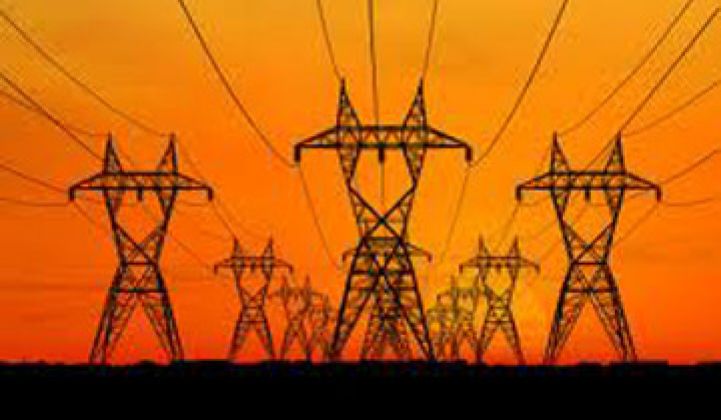San Francisco, Calif. --- We are reporting from an IQPC energy storage event attended by a cross-section of the grid industry from utilities to regulators to the DOE to energy storage technologists. There are even representatives from a few solar firms like First Solar and Solon.
But the question asked in the title of this piece remains unanswered. What are the real costs of energy storage and who pays for it?
Energy storage, other than the few pumped hydro and CAES plants in operation, is still a wide-open field. What technology will work? How much will it cost? What are the benefits? And how will it be regulated? These crucial questions are being answered in real time by entrepreneurs, utilities, and regulatory bodies.
EPRI's Dan Rastler, Director of Energy Storage and Distributed Energy spoke at the event. He's an energy storage expert and is well aware of the missing pieces to the energy storage puzzle.
Rastler and his group have produced an epic document on energy storage, as well as a executive summary white paper that are well worth reading if energy storage is of interest to you.
In Rastler's words, "You have to understand the application." Storage looks like "a load and a generator that touches different parts of the grid." It comes in different sizes from bulk to distributed to consumer. "There's no single analytical bullet that works."
The Need for Standards in Storage
Rastler spoke of the need for energy storage standards and suggested a 1-megawatt X 2-hour transportable storage unit as a practical size and modular element. EPRI looks to write the specs for this box.
"As an industry, we're still trying to get our hands around this. We're not there yet," he said.
Storage Technology Choices
Rastler's take on technology: "We don't see Sodium Sulfur batteries coming down in price that much." (See the article on the proposed Rubenius NaS project.)
What Rastler does see as a technology with cost-reduction potential is lithium-ion -- with excess factory capacity and economies of scale driven by the growth of the electric vehicle market. Rastler spoke of 35 gigawatt-hours of lithium-ion battery capacity being available globally by 2015.
Li-ion is a 15-minute system. Rastler said, "We would like a 4- to 6-hour Li-ion system in a box," although his "clients say that two hours would work."
Rastler added, "We have to establish a grid-storage track record because we don't have any experience with lithium-ion on the grid."
We've covered storage technologies at Greentech Media ranging from new battery technology to underground pumped hydro to innovative thermal storage to CAES to big rocks.
Storage Policy and Regulatory Regimes
Janice Lin, a storage policy consultant at Strategen, spoke of an electrical grid composed of generation, transmission, distribution, and load. Storage is "blessed and cursed with the ability to address those four segments. Because storage fits everywhere, it is not regulated under any of those applications."
Without a market mechanism for pricing energy storage and without a regulatory framework, energy storage can't make it into the utility grid. Utilities have to make money off of their assets and if energy storage is not categorized as transmission, distribution, generation, or load -- then utilities will not know how to place it onto their rate base. It's only a minor exaggeration to say that even if storage were free, utilities still wouldn't know how to address it in their rate base.
Robert Schainker, EPRI's Senior Technical Executive for Power Delivery and Utilization, sees the regulatory climate as very favorable for storage from agencies ranging from the FERC to the CPUC. (See this article on California's landmark storage bill.)
Energy Storage Costs
The mantra at most energy storage gatherings is "generating income from multiple revenue streams."
Energy storage remains too spendy for single-function grid applications. But if you stack the benefits, you might see an economic case begin to emerge.
According to Ben Kaun of EPRI in an article in Smart Grid News, "Energy storage assets can provide numerous benefit streams to system operations, including frequency regulation, peak demand capacity, and output smoothing and shifting intermittent renewable resources. It can also serve more localized needs through T&D upgrade investment deferral, enhanced power quality and improved reliability for households and businesses."
According to Rastler, "When we speak of cost, we speak of the all-in cost to install a step-up transformer -- whatever it takes to get it to utility use," adding, "We think two-hour systems will be about $1,200 per kilowatt." But he stressed that "we really need to see a fully installed system under $300 to $400 per kilowatt-hour."
Michael Kanellos writes on pairing solar with storage here.
Some other points and open questions from this conference:
- Can storage improve the emissions profile of a combined cycle plant by optimizing efficiency?
- Is fast wholesale regulation the low-hanging fruit?
- A lot of utilities are rolling storage into the smart grid rate case -- storage as a smart grid asset
- How can storage support the enormous amount of wind coming on-line in Texas and California?
- Storage competes with gas turbines.
Rastler summed up, saying, "Operating costs are still high in storage. We need lower costs, higher life cycles, and better efficiencies."



